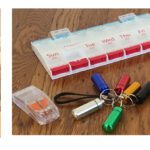Tabsafe Medication Dispenser : Review
By: Editorial Team | Posted: February 2, 2020 | Updated: April 25, 2023
The Basics
- Product: Tabsafe
- Company: Medication Solutions
- Review Date: Q1 2020
Where to buy it or learn more*:
Discount for Tech-enhanced Life readers:
- Discount code:
- Discount amount:
Analyst Summary: Medication Solutions | Tabsafe
The Tabsafe is designed to help you improve your adherence to the medication regimen prescribed by your healthcare providers. It does that by helping to organize your medication; and remind you which pills to take and when to take them.
This product is included in our comparative analysis of the entire class of automatic pill dispensers. If you are not sure yet whether this product is the one you need, that comparative evaluation should help you understand which pill dispenser will work best for your life situation.
The Tabsafe is a powerful system capable of dispensing large numbers of pills according to a complex regimen. However we found it a little “non-user friendly” compared to its competitors, and think it is best suited to situations where a trained professional caregiver or nurse is managing a patient’s medication, rather than situations where an indiviudal manages their own medication or a family member helps them to do so.
Unlike the family of “robot pill organizer / dispensers” (see article above for details), which we see as “competing products” to this one, the Tabsafe does NOT do the work of organizing your pills into different dose groupings for you inside the system.
Which Medications Can It Handle?
The system has some limitations. Here is what the manual says:
“Oval shaped tablets and capsules no longer than 0.875 inches will fit into a TabSafe cartridge. Round tablets, with a diameter no wider than 0.51 inches, will fit in a TabSafe cartridge. Tablets must also have a thickness of more than 0.077 inches or they may slip out the exit point in the cartridge unintentionally. …. Geltabs of any size cannot be filled in a TabSafe cartridge, as the coating will cause these medications to stick.”
The system can be configured to send you a “message” when it is time to take other medications that are not stored in the system.
User Interface (UI)
One of the common scenarios in which these types of products will be used involve two different people. One, which we call the “dispensee”, is the person who consumes the medication, and who needs to interface with the machine when it is time for the medications to be dispensed.
The second, which we call the “filler”, is the person who worries about putting the right medication into the system every week or month, and who sets up the “dispensing schedule” according to whatever schedule has been prescribed by the physicians of the dispensee.
In many scenarios, the filler will be a caregiver, or spouse, or adult child of the dispensee. However there will also be situations in which the dispensee also performs the job of the filler (i.e. when you worry about your own medication management instead of involving someone else).
This product has two separate interfaces. For the Dispensee, there is a blue screen which contains messages (like “Good Morning”), a large blue button to press when it is time for medication, and a drawer that pops open with your medication after the button is pressed.
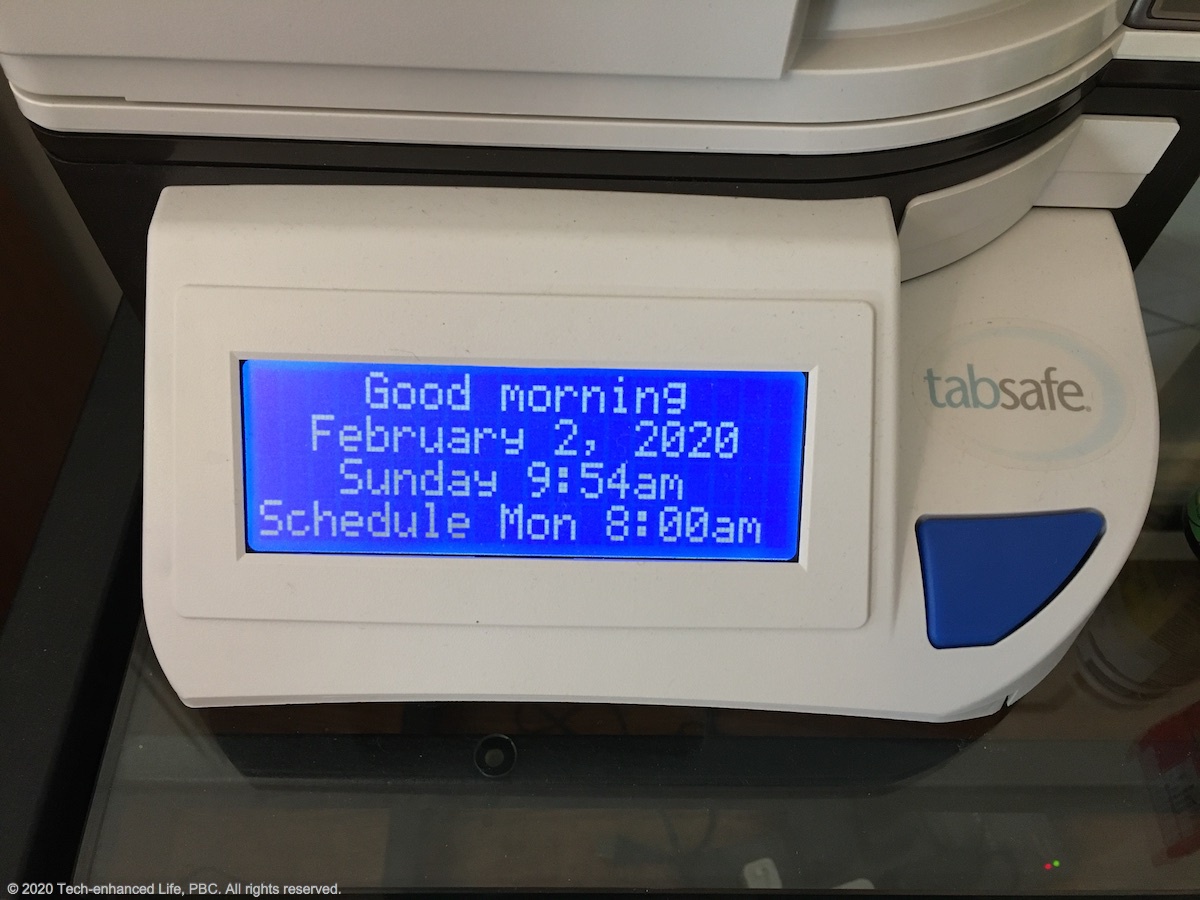
Caption: Tabsafe Dispensee Interface.
The “Caregiver Interface” is on a pull out keypad that is somewhat hidden under the unit.
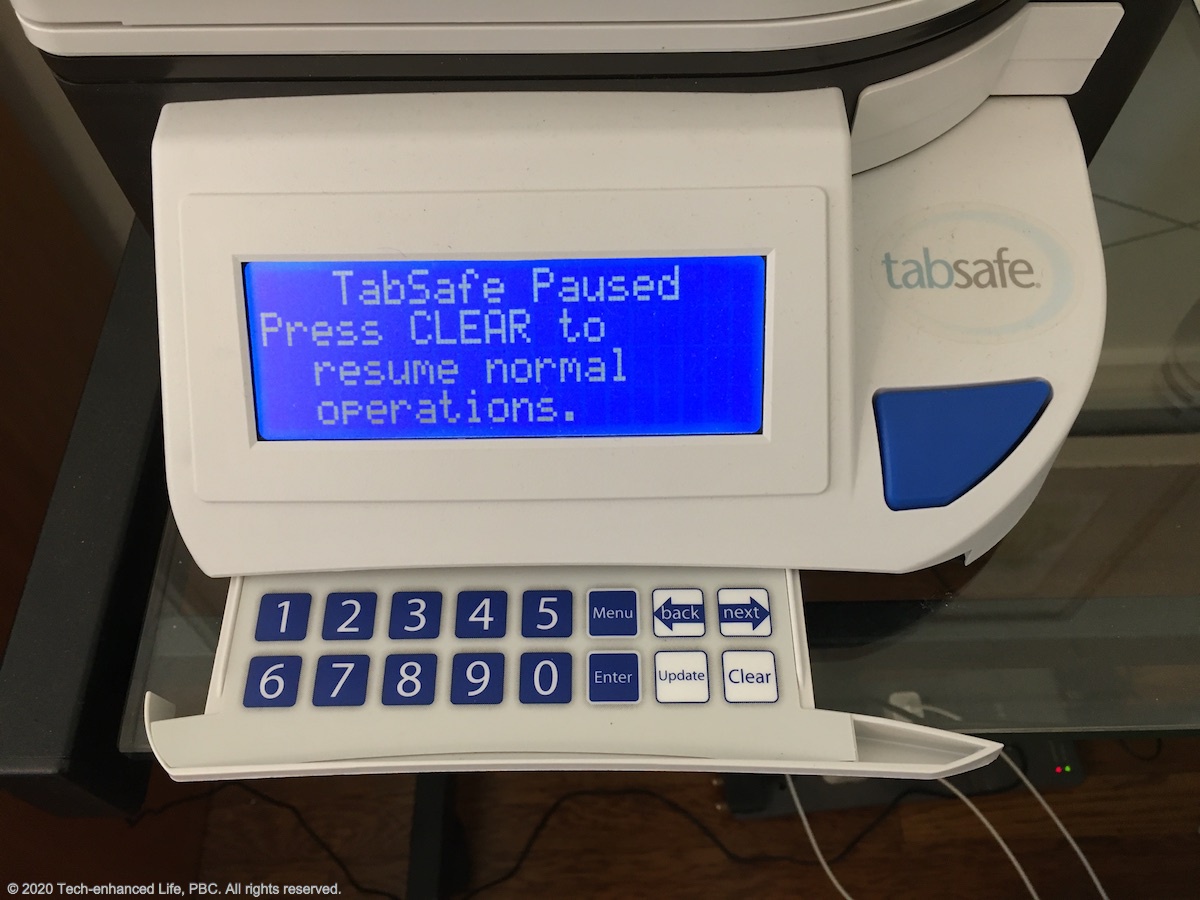
Caption: Tabsafe Caregiver Interface.
A System based on “Pill Trays”
This system differs from most of the other products we evaluated in how it works. It contains multiple “pill trays” (in contrast to products like the GMS or MedMinder which have a single pill tray).
The way it works is that there is a separate “pill tray” for each “dose time”. So if you have four dose times during the day (eg 8am, 12 noon, 5pm, 10pm), then you use 4 separate trays. Each tray has either 16 or 32 compartments (there are two sizes) and the idea is that each tray can carry 16 or 32 days of that dose time medications. See images below.
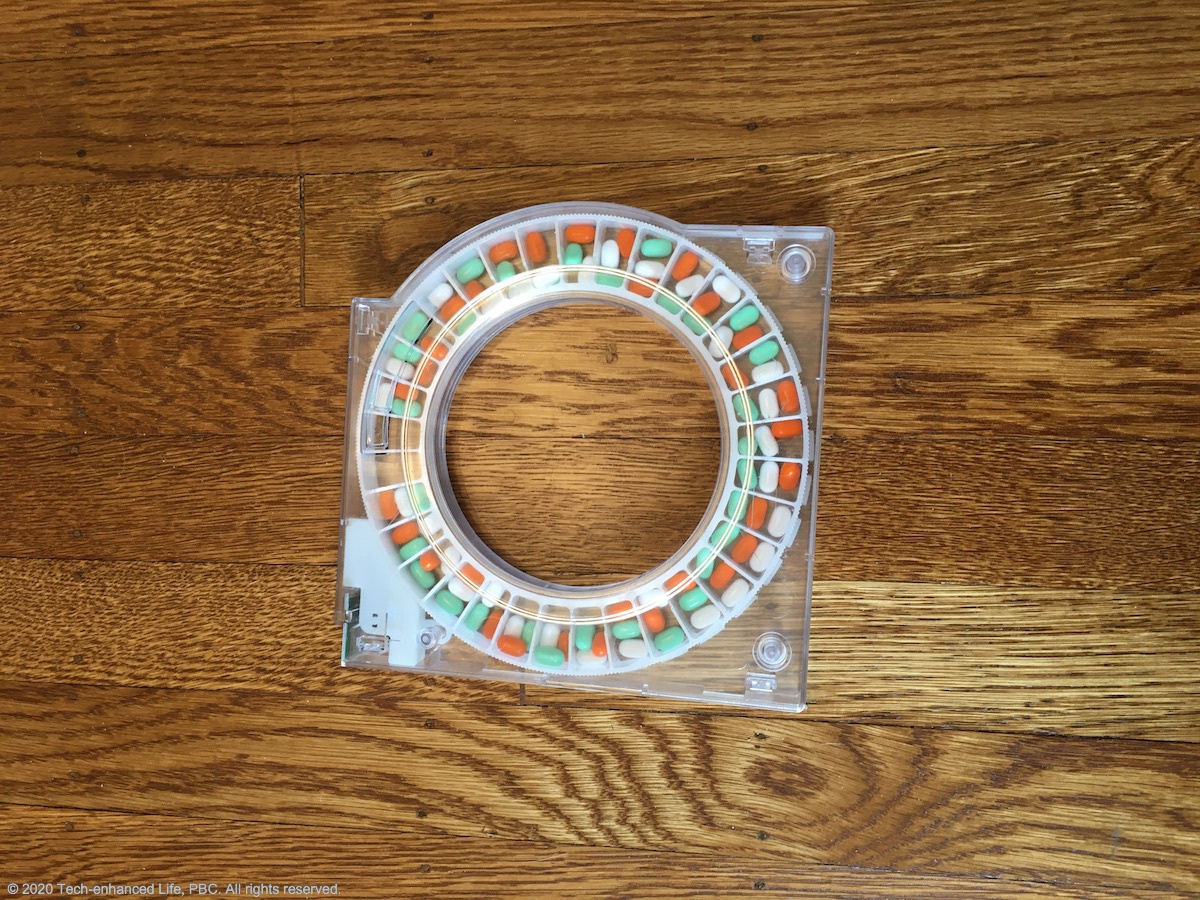
Caption: A filled pill tray before insertion into the system
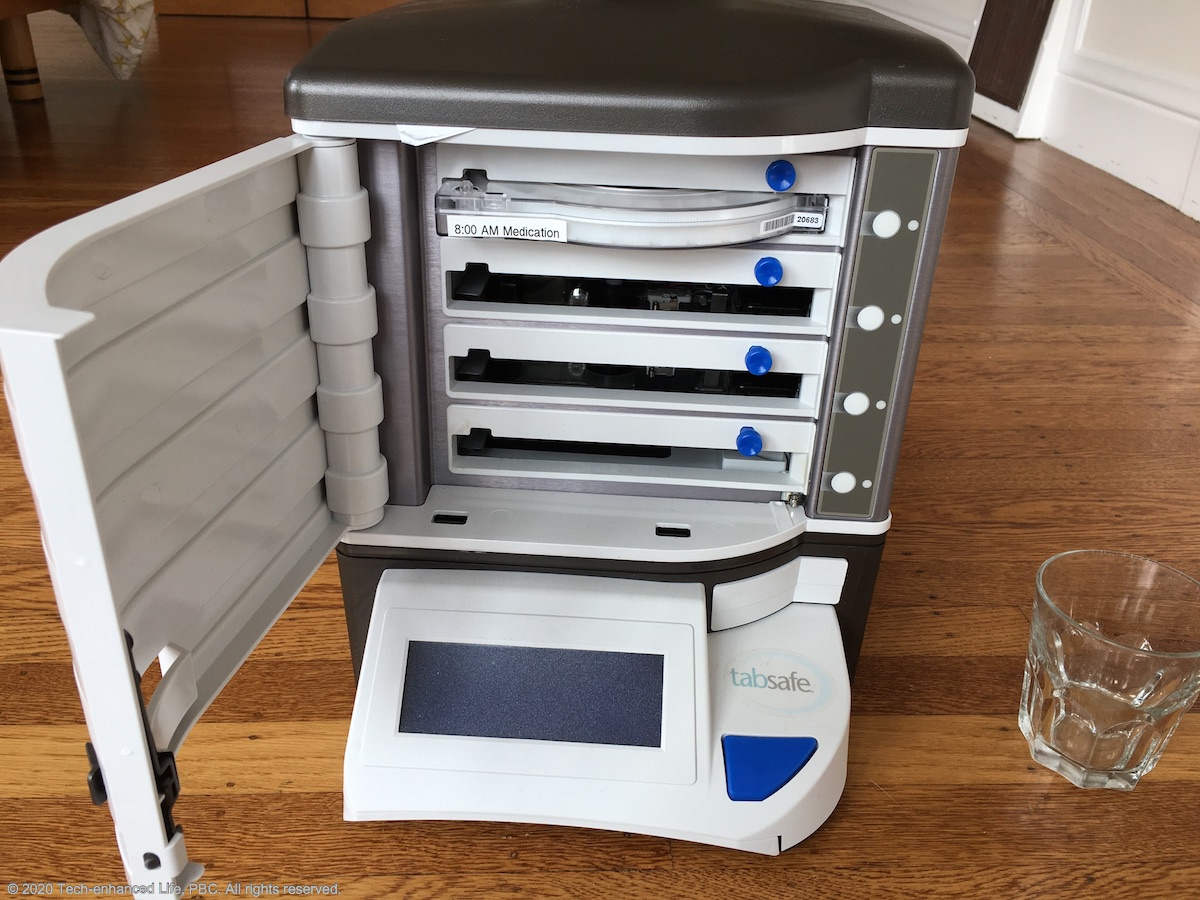
Caption: machine showing where the pill trays are inserted, and one tray (8am dose) installed.
Programming Medication Schedule
The Tabsafe system itself has no real “programming interface” on it. Getting the right medications into the right compartment is up to the “filler” (see filling below).
However, there is a web “portal” that connects to the Tabsafe system, and in which you can adjust a variety of things relating to the machine.
For example, you use the portal to set the time at which each dose is to be given, and set whether specific trays are to be used for a regular scheduled dose, or for “as needed” medications.
Limits on Complexity of Regimen
The basic system comes with 4 pill trays, which means you can have up to four dose times per day (similar to many of the competing systems based on pill box concepts). However, the Tabsafe is “expandable” and you can have as many as 12 pill trays, giving it the capability of 12 doses per day and up to 32 days worth for each dose time.
One important detail to note is that the individual compartments in the trays are fairly small, thus holding a modest number of pills. See the capacity section for more.
Filling (Putting Pills into the Device)
In our opinion, how well the product handles the “filling” step is a key differentiator between various pill dispenser systems and smart pill boxes. The Tabsafe is powerful, but not “easy”.
How Filling Happens
Option 1: The default way to fill this system, is to fill by hand each compartment in each of the multiple pill trays.
The system comes with a sort of “template” that you use to open up each pill tray, then it is fairly easy to add pills by hand. After filling each tray, you reinsert it into the system.
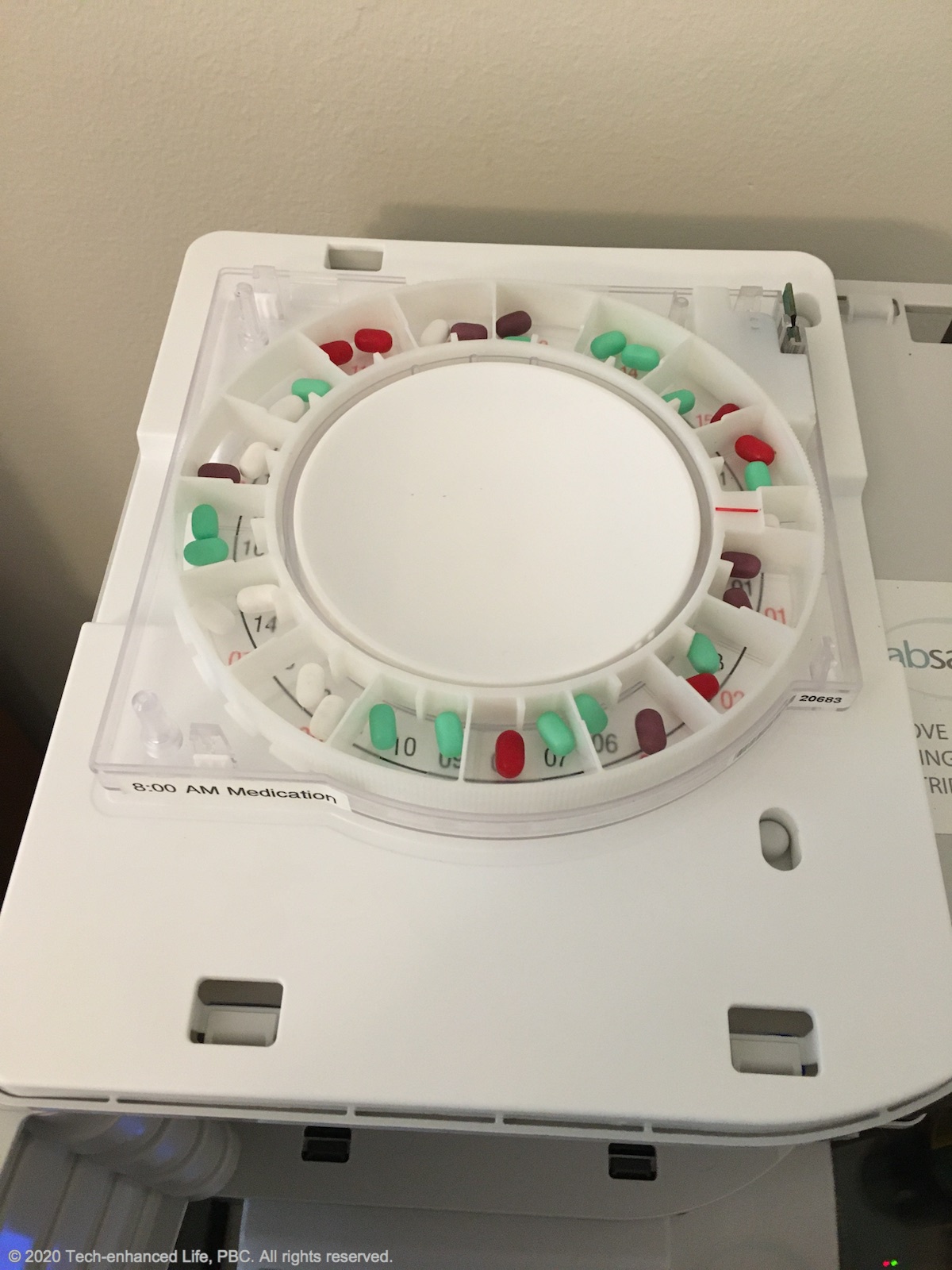
Caption: Tabsafe tray being filled.
Option 2: The company’s website mentions the idea that a pharmacy could fill the pill trays for you. That would be a very interesting feature and would make filling this product much easier. When we enquired about the availability of this, we learned that it is not something you can just get any old pharmacy to do. But if you decide you are interested in this product, it is worth contacting the company directly and asking if this is an option in your geography. The company also mentioned the idea that you could order your pills from PillPack, and then just put the contents of each pouch into the appropriate pill compartment.
Capacity
The system can handle a large number of pills, as well as handling up to 12 doses per day. See Automatic Pill Dispensers: Hands-on Evaluations for a chart with “capacity” comparisons between this and the competing products.
Camera / Barcode Scanner / Medication Database
There is no medication database or barcode recognition capability.
How it Communicates: Voice, Beeps, Lights etc
The system beeps, flashes a light, and talks to you (in a robot voice) when it is time for a dose. You cannot record a message in your own voice.
Early / Late / Missed Doses / Flexibility
You can use the Caregiver interface on the machine to dispense “advance medications” for up to 7 days.
Separation between Dispensee and Filler Roles
An important aspect of products like this is whether or not they lend themselves to being used in situations where the “filler” and “dispensee” are two distinct people. And, in particular whether or not they can be set up so that the Dispensee can be prevented from adjusting the medications and or taking the wrong pills at the wrong time.
For the Tabsafe, there is a hard separation between these roles. You cannot access the pill trays without a key, or the portal without a password. In addition, you can set a PIN to prevent the Dispensee accidentally using the caregiver menu even if they pull out the caregiver keyboard.
So, this system has good separation between the dispensee and caregiver / filler roles.
Physical & Cognitive Impairments
In terms of physical impairments, the system seems well designed from the point of view of the dispensee. The blue button is large. The light that flashes to notify you is fairly bright. And the sound is fairly loud. There is no requirement for reading small print or pressing small buttons. Overall, the dispensee interface is very similar to the Philips product.
The filler needs to have excellent dexterity and high functioning cognition, and be comfortable learning how to operate a relatively complex system reminiscent of a laboratory or scientific instrument rather than a piece of consumer electronics.
“Time to Refill”
This system is designed to work on a schedule in which it gets filled weekly or every 2 or 4 weeks, depending on the number of medications.
Set Up & Connectivity
Connectivity
The Tabsafe system connects to the internet using WiFi. It can also come in a version that connects via a “landline”. It does not have an option to connect via a cellular connection at present, although the company says they are working to change that.
We found setting up the WiFi relatively straightforward if you are used to connecting routers and the like to your network, but not super friendly, and harder than some of the competitors. We think this will be challenging for many consumers.
General Setup
Setting the system up for the first time requires turning it on, and logging into the Tabsafe portal. Then you choose some settings relating to medication routine and notifications, and it is ready to go. As “setup” routines go, it seemed OK, although definitely more complex than most of the systems we evaluated in this study..
Portal or App
The portal is clearly capable of handling multiple Tabsafe products in the same account — presumably targeting professional caregivers.
The portal allows you to look at some reports that track the days medications were or were not taken correctly, inventory status, and more.
Remote medication adjustment
The portal allows you to change the times of specific trays. But to adjust any specific pills you need to open up the pill trays and make those changes manually.
Caregiver Monitoring
The product clearly has in mind the scenario of a professional caregiver who is involved in helping to manage the medications of someone else (an older adult for example). It has some phone notification capabilities that we found a bit confusing. It was not easy to have it send us a text or an email, and we believe that is not possible. However it seems that you can have it give you a call by phone in situations where a dose was not taken, although we did not test that capability.
Additional Features & Details
Security & Anti-tampering
Dispensee with Cognitive Impairment
The key on the pill compartment, and strong separation between dispensee and filler interface make this product suitable for use with dementia patients.
“Others” Using your Meds
There is a separate situation which some of the products in this category worry about. That is the situation in which the wrong person takes “your” pills. A topical example is in the case of opioids, for example, where you do not want others with access to the house to be able to take “your” opioids. This product does address this situation by giving you the ability to set a PIN for dispensing. However this is the same PIN that gives you access to the entire caregiver menu, so this is not an ideal implementation.
Hacking the System
Because it is connected to the Internet, it is theoretically possible someone could hack into and gain control of the system. In our opinion, anything connected to the Internet is potentially hackable, and we would bet this product is no exception. It’s like the decision to use a phone or a computer, or Alexa, or any other piece of useful technology. You make a decision whether the risk of being hacked does or does not outweigh the potential benefits. In this case the potential benefits are significant.
Power & Battery Backup
The system is designed to be plugged in to the power outlet. It includes a battery backup, which the company says lasts for at least 12 hours.
Vacations & Trips & Leaving the House
We went away for a couple of weeks while using the product. We simply turned it off and left it. When we returned we turned it back on, and it started working again immediately without needing any “set up”.
You can dispense up to a week of pills in advance.
We think actually taking the system with you when you travel would be difficulty as it is large and bulky and not very easy to setup.
Aesthetics
This product appears dated (it was designed quite some time ago) and also looks like a clinical or scientific instrument rather than like a piece of consumer electronics. It is like the Philips product from this point of view. It is notably different to the more modern crop of robot pill organizers that try hard to look like a kitchen appliance or piece of consumer electronics.
Manual, Support, Training
You can download an extensive manual.
Languages: Documentation and the interface seem to only come in “English”.
Where to buy it or learn more*: (this takes you away from our website)
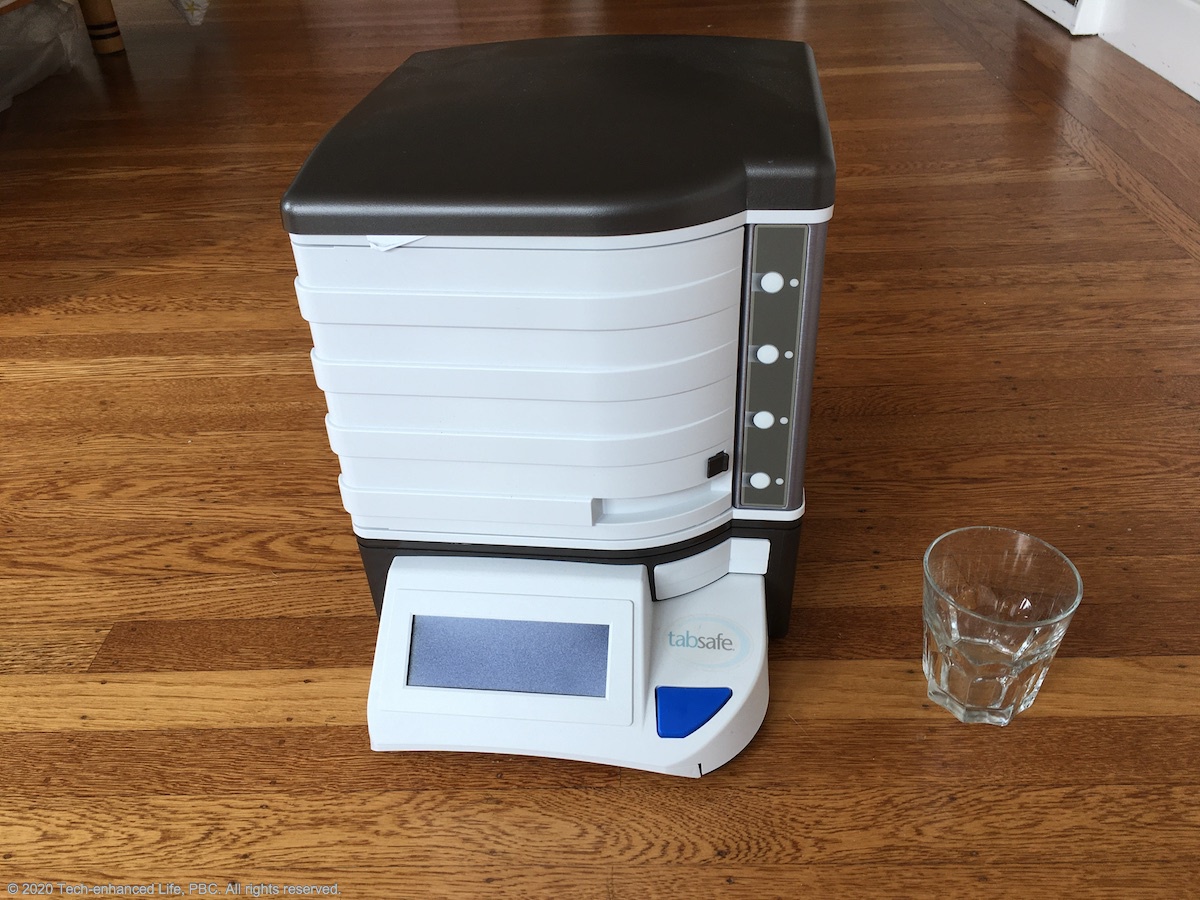
Discount for Tech-enhanced Life readers:
- Discount code:
- Discount amount:
*Disclosure: The research and opinions in this article are those of the author, and may or may not reflect the official views of Tech-enhanced Life.
If you use the links on this website when you buy products we write about, we may earn commissions from qualifying purchases as an Amazon Associate or other affiliate program participant. This does not affect the price you pay. We use the (modest) income to help fund our research.
In some cases, when we evaluate products and services, we ask the vendor to loan us the products we review (so we don’t need to buy them). Beyond the above, Tech-enhanced Life has no financial interest in any products or services discussed here, and this article is not sponsored by the vendor or any third party. See How we Fund our Work.
